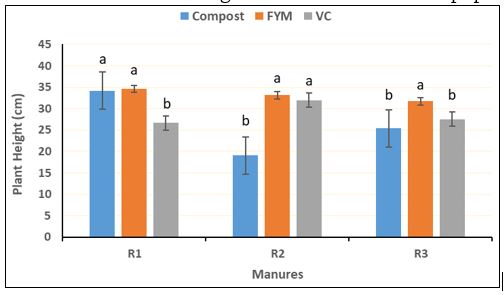Assessment of Three Fast Growing Populus Deltoides Species in Various Soil Profiles Under Nursery Conditions
Keywords:
Soil Carbon, Biofuel Plants, Agroforestry, Rangeland ManagementAbstract
Populus plants are fast-growing plants exhibiting strong adaptability and a short rotation period, with enhancing ability of carbon stock, helping in combating climate change and sustaining livelihoods. Pakistan has a shortage of firewood and timber. Thus, hybrid fast-growing plants are the only way to balance wood demand and supply in country. Therefore, objective of the present study was to evaluate and compare the growth patterns and carbon stocks of Populus deltoides varieties in soil media under nursery conditions. To achieve this, three fast-growing hybrid species of Populus deltoides, Italian Populus (euramerciana), clone A-Y48, and local Populus were used. Three healthy plants of mothers aged one to two years were selected from field area of the Rangeland Research Institute, NARC. The cuttings were planted in 90 pots after being filled with three different media, and plant growth was recorded after seven days for the number of leaves, height, diameter, and irrigations frequency applied to each pot. Three-month data were collected and analyzed by using an RCBD design. Afterwards, all the plants were harvested, and soil samples were taken from the pots and brought to the RRI laboratory for estimation of total biomass and carbon stocks. It was concluded that Clone AY-48 achieved highest height among all Populus deltoides varieties and stored more carbon stock in comparison to Italian and local poplar varieties. Farmyard manure had a positive influence on height of the different Populus deltoides varieties. Clone AY-48 and Italian poplar plants are more suitable for rapid growth.
References
“FAO. (2009). Statistics for APFSOS II - IGF Office, Ministry of Environment, APFSOS II Conference Chiang Mai, Thailand”.
P. (2011), “Pakistan Economic Survey. Highlights: Agriculture Economic Adviser’s Wing, Finance division, Govt. of Pakistan, Islamabad”.
“Forest Wood Consumption and Wood Shortage in Pakistan: Estimation and Projection through System Dynamics on JSTOR.” Accessed: Jun. 22, 2024. [Online]. Available: https://www.jstor.org/stable/44986435
“Plantations industrielles d’arbres a croissance rapide: réalités, risques et solutions”, [Online]. Available: https://www.wwf.fr/sites/default/files/doc-2018-07/20180702_Rapport-plantations-industrielles-arbres-croissance-rapide-min.pdf
N. K. Kutsokon, S. Jose, E. Holzmueller, N. K. Kutsokon, S. Jose, and E. Holzmueller, “A Global Analysis of Temperature Effects on Populus Plantation Production Potential,” Am. J. Plant Sci., vol. 6, no. 1, pp. 23–33, Jan. 2015, doi: 10.4236/AJPS.2015.61004.
A. Kumar et al., “Response of Farmyard Manure (FYM) on Growth and Flowering of Different Marigold (Tagetes erecta L.) Varieties,” Am. J. Plant Biol. 2023, Vol. 8, Page 30, vol. 8, no. 2, pp. 30–35, Jul. 2023, doi: 10.11648/J.AJPB.20230802.12.
H. Pretzsch, T. Knoke, C. Paul, J. Bauhus, and D. I. Forrester, “Perspectives for Future Research on Mixed-Species Systems,” Mix. For. Ecol. Manag., pp. 579–606, Jun. 2017, doi: 10.1007/978-3-662-54553-9_12.
M. W. H. Evangelou, H. M. Conesa, B. H. Robinson, and R. Schulin, “Biomass Production on Trace Element–Contaminated Land: A Review,” https://home.liebertpub.com/ees, vol. 29, no. 9, pp. 823–839, Aug. 2012, doi: 10.1089/EES.2011.0428.
D. S. Adi et al., “Exploration of Unutilized Fast Growing Wood Species from Secondary Forest in Central Kalimantan: Study on the Fiber Characteristic and Wood Density,” Procedia Environ. Sci., vol. 20, pp. 321–327, Jan. 2014, doi: 10.1016/J.PROENV.2014.03.040.
“Management of hybrid poplar for optimum yield of wood.” Accessed: Jun. 22, 2024. [Online]. Available: https://researcherslinks.com/email-this-article-to-colleague/management-of-hybrid-poplar-for-optimum-yield-of-wood/41/5/9054
“The Management of Industrial Forest Plantations: Theoretical Foundations and Applications | SpringerLink.” Accessed: Jun. 22, 2024. [Online]. Available: https://link.springer.com/book/10.1007/978-94-017-8899-1
G. Arora et al., “Growth, biomass, carbon stocks, and sequestration in an age series of Populus deltoides plantations in Tarai region of central Himalaya,” Turkish J. Agric. For., vol. 38, no. 4, pp. 550–560, Jan. 2014, doi: 10.3906/tar-1307-94.
S. Razvi, S. Nautiyal, R. Prakash, A. Bhat, and M. M. Rather, “Vegetative Propagation of Bambusa Vulgaris Var. Striata (Yellow Bamboo) through Juvenile Branch Cuttings: a New Technique,” Indian For., vol. 138, no. 4, pp. 392–394, Apr. 2012, doi: 10.36808/IF/2012/V138I4/4648.
K. L. Kline and M. D. Coleman, “Woody energy crops in the southeastern United States: Two centuries of practitioner experience,” Biomass and Bioenergy, vol. 34, no. 12, pp. 1655–1666, Dec. 2010, doi: 10.1016/J.BIOMBIOE.2010.05.005.
T. J. Tschaplinski et al., “The nature of the progression of drought stress drives differential metabolomic responses in Populus deltoides,” Ann. Bot., vol. 124, no. 4, pp. 617–626, Oct. 2019, doi: 10.1093/AOB/MCZ002.
& K. Y. Yeo Jin-gi, Woo Kwan-soo, Koo Young-bon, “Growth characteristics and adaptability of 3-year-old poplar and willow clones in riverside areas,” Environ. Restor. Green., vol. 10, no. 5, pp. 40–50, 2007.
K. G. Mandal, K. M. Hati, and A. K. Misra, “Biomass yield and energy analysis of soybean production in relation to fertilizer-NPK and organic manure,” Biomass and Bioenergy, vol. 33, no. 12, pp. 1670–1679, Dec. 2009, doi: 10.1016/J.BIOMBIOE.2009.08.010.
B. Sarma and N. Gogoi, “Germination and seedling growth of Okra (Abelmoschus esculentus L.) as influenced by organic amendments,” Cogent Food Agric., vol. 1, no. 1, Dec. 2015, doi: 10.1080/23311932.2015.1030906.
A. A. Sher, D. L. Marshall, and S. A. Gilbert, “Competition between Native Populus deltoides and Invasive Tamarix ramosissima and the Implications for Reestablishing Flooding Disturbance,” Conserv. Biol., vol. 14, no. 6, pp. 1744–1754, Dec. 2000, doi: 10.1111/J.1523-1739.2000.99306.X.
J. R. Reeve, L. Carpenter-Boggs, J. P. Reganold, A. L. York, and W. F. Brinton, “Influence of biodynamic preparations on compost development and resultant compost extracts on wheat seedling growth,” Bioresour. Technol., vol. 101, no. 14, pp. 5658–5666, Jul. 2010, doi: 10.1016/J.BIORTECH.2010.01.144.
R. F. Channagouda, H. B. Babalad, and S. P. Dineshkumar, “Effect of organic manures, green leaf manures, liquid organic manures and micronutrients on yield and economics of cotton (Gossypium spp.),” Indian J. Agric. Sci., vol. 85, no. 10, pp. 1273–1278, Oct. 2015, doi: 10.56093/IJAS.V85I10.52247.

Downloads
Published
How to Cite
Issue
Section
License
Copyright (c) 2024 50SEA

This work is licensed under a Creative Commons Attribution 4.0 International License.




















